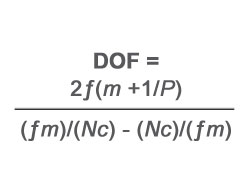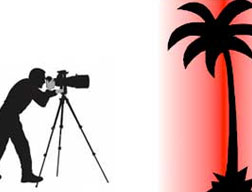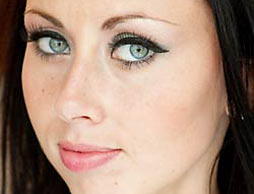Your tutorials are the best I have found in 12 years of using a camera! Bert Fedor - Birmingham, AL
Free online photography & image editing tutorials
Welcome to your free tutorials, I'll let you know by email any time I add a new one
What controls Depth of Field?
Now it gets interesting. The basic factors determining DOF are:
- The distance between your camera and your subject
- The focal length of your lens (for example 18 mm or 100mm)
- The size of your aperture (for example, f/2.8 or f/16). Remember large number = small aperture.
There are other technical factors involving the sensor or film in your camera, but we're not going to worry about those, because they are basically a given and out of your control.
Compare the two following illustrations to see how changing the focal length and aperture affect the DOF of an image.
Example 1
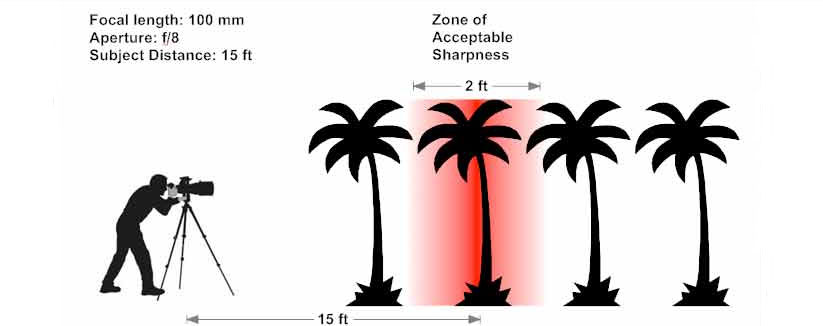
Example 2
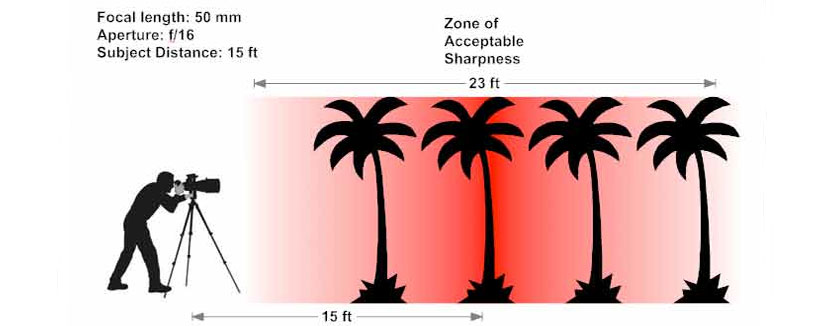
I'm not going to explain the math of why this happens. All you need to understand are the following general rules of thumb:
- The wider the aperture, the shallower the DOF (e.g., f/4 creates shallower DOF, and thus more blur, than f/16)
- The longer the focal length of the lens, the shallower the DOF (e.g., a 200 mm telephoto lens creates shallower DOF than a 22 mm wide angle lens)
- The closer you are to your subject, the shallower the DOF
Experimenting to see how Distance, Aperture, and Focal Length Affect DOF
Compare the following series of photos that I took of two guitars to show what happens to DOF when I change distance, aperture and focal length. In each case I'm focusing on the red guitar.

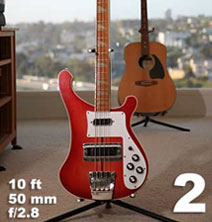
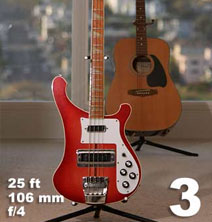
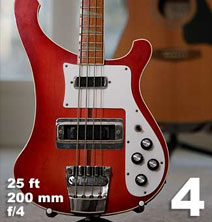
Image 1:
- Distance 6 ft
- Focal length 23 mm
- Aperture f/16
With a relatively small aperture like f/16 (remember, the higher the f-number the smaller the aperture), we have a very deep DOF. In fact, the DOF extends to infinity in this image. Even the buildings in the background, on the horizon, are in focus.
(If you want a fancy term to toss around at cocktail parties, when you focus on an object beyond what is known as the hyperfocal distance, you produce a depth of field that extends to infinity in the background).
Image 2:
- Distance 10 ft
- Focal length 50 mm
- Aperture f/2.8
I had to back up a few feet to keep the guitar framed at 50 mm. If nothing else had changed, moving farther from my subject would increase the DOF, but this factor was overwhelmed by radical changes in aperture and focal length.
The combination of greater zoom (50 mm) and much wider aperture (f/2.8) create a much shallower depth of field. As you can see in the image, not only has the distant background gone out of focus, but even the second guitar is slightly blurred. If you do the math, the DOF for this image calculates to just over 1 foot. Everything outside of the 1-foot-deep zone around the red guitar will be out of focus, increasingly blurry with distance from that guitar.
Image 3:
- Distance 25 ft
- Focal length 106 mm
- Aperture f/4
Now we're starting to see the compression and flattening of the image that you get when you zoom in with a long lens. The 106 mm focal length gives us a tight field of view the relatively wide aperture makes for a shallow DOF. However, both of these factors are offset by moving farther away from the subject. Crunching the numbers tells me that the DOF for this image is just over 2 feet, actually slightly deeper than in Image 2. Despite the big increase in focal length, the greater distance and slightly smaller aperture combined to give us a wee bit more DOF than in the previous image (but still not enough for anything but the red guitar to be in focus).
Image 4:
- Distance 25 ft
- Focal length 200 mm
- Aperture f/4
Maximum zoom and maximum aperture on my 70-200mm f/4 lens gives a very tight field of view and a very shallow depth of field. I can't keep the entire red guitar in the frame any more. And clearly, not only is the second guitar far out of focus, but the distant background has become a featureless smear of color and light. Crunching the numbers tells me that DOF is about 7 inches in this image. This kind of shallow DOF can really isolate your subject from the background.
In the series of guitar images, we've seen DOF go from infinity in Image 1 to a thin slice just 7 inches deep in Image 4. This is why we spend the money for SLR cameras and those big, heavy lenses with wide apertures. Among other benefits, that cumbersome professional gear gives us the ability to control the depth of field.
You can also understand why a tiny point-and-shoot camera with a pinpoint aperture and extremely short focal length does not give you much control over depth of field. It's easy for such a camera to create extensive DOF (often infinite) but very hard for it to create shallow DOF.
That's all fine and good—but what can you do with DOF?
A final thought: Don't just settle for a Depth of Field—Choose it!
There's a tendency among many beginning photographers to exploit the "professional" look of shallow DOF by always choosing the largest possible aperture and then shooting away. The first time you acquire a big, fast lens this power can be intoxicating.
You can move beyond that stage by consciously choosing how much DOF you want your image to have, before you put your camera to your eye—deciding exactly what you want to have in focus, and out of focus—then adjusting your position and camera settings until you get it.



